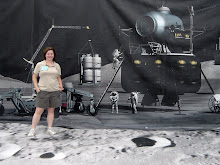Here’s another question from the blog comment box: "Riddle me this Science Girl....I just read
this story on CNN. What is so new about ground penetrating radar. It has been around for a long time hasn't it? What kind of crystals are embedded in the iron and why are they important? What is with the white gloves? The thing has been in the ground on earth for 10,000 years, isn't that just a little dramatic?"
Pallasites are very rare meteorites. They are basically big crystals of olivine (in gemstone form, olivine is known as
peridot) embedded in iron-nickel metal. Besides being incredibly beautiful, they’re scientifically interesting, but it takes a step back to explain why, so bear with me. Like the Earth, many planets heated up when they formed and the materials separated out roughly by density. We see that today on Earth as the
crust, mantle, and core. Mars has a similar structure, and so does the asteroid Vesta, and probably so did many other asteroids that have since been blown into pieces by collisions. Pieces that fall to earth of these exploded tiny planets are recognizable as pieces of otherworldly crusts (achondrites) and cores (iron meteorites). We
don’t have any meteorites that are definitely mantle material, but the Earth’s mantle is made largely of olivine, and remote sensing of
Vesta and
the Moon show olivine-rich material in deep craters, so by analogy, we think that asteroid mantles are made of olivine too. Where would olivine mix with metal? At the core-mantle boundary. So pallasites are samples from the core-mantle boundary of asteroids, a relatively narrow zone and so therefore relatively rare.
This specific meteorite, the Brenham pallasite, is one that has gotten amateurs excited for years. Smaller pieces of this meteorite have been found in farmers’ fields all throughout the midwest. Traditionally, meteorites are found by stumbling across them by accident or by systematically sweeping an area by eye or with metal detectors. In the case of Brenham, people suspected there could be more pieces lurking below the surface, and last year,
meteorite hunters found the biggest piece of Brenham using a metal detector. The piece described in today's news story was found by combining two pursuits: looking for more pieces of Brenham and validating a hand-carried ground-penetrating radar instrument (that’s the “new” part of the radar) to find local buried resources, like meteorites and water (read more about that in
the more explanatory AP story). OK, maybe white gloves are overkill considering all the other organic stuff that’s been crawling over the meteorite, but the recovery party (in part from the
curation staff at the Johnson Space Center) was following standard protocol for recovering meteorites, which includes trying not to transfer any human skin oils to the meteorite. While it may have been on Earth a long time, it probably hasn’t been touched by humans ever.
Honestly, I did not plant this question, but it allows me a very graceful segueway into my next planetary adventure: the Antarctic Search for Meteorites. More on that in my next installment!
 Spirit made it through Sol1K successfully! We have data products on the ground with the sol 1000 timestamp. But 1000 sols can really take its toll: Mars Rover Beginning to Hate Mars. Bruce Banerdt assures me that his comments “were taken completely out of context.”
Spirit made it through Sol1K successfully! We have data products on the ground with the sol 1000 timestamp. But 1000 sols can really take its toll: Mars Rover Beginning to Hate Mars. Bruce Banerdt assures me that his comments “were taken completely out of context.”
